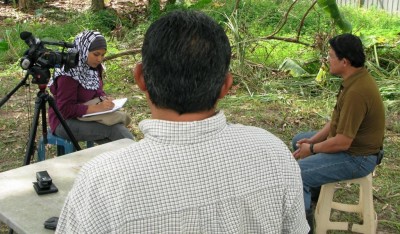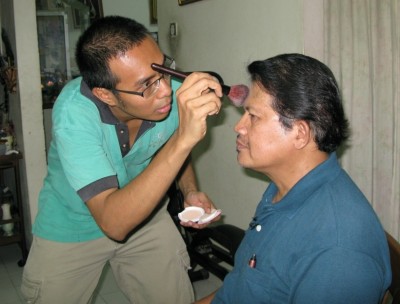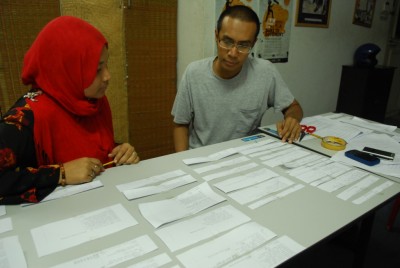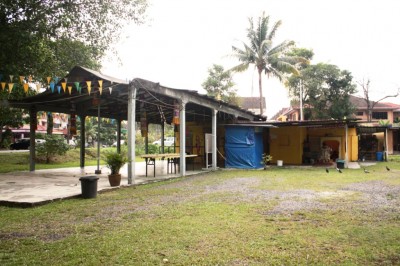Sheridan Mahavera and Siti Nurbaiyah Nadzmi have been working together since 2007. They have 30 years of award-winning journalism between them and continue to write for some of the country’s well-known print and online publications They have written on disparate subjects from a Malaysian woman that was trapped in South Korea since World War II to pre-Islamic healing rituals of Kelantan to vilages in North Johor that have been decimated by AIDS.Their collaborative work is something to look forward to since they have conflicting views on almost everything -from where to have lunch to how to best save the environment. This is their first documentary.
“Kisah Tauke Mancis dan Minyak Tumpah” is a half-hour documentary about a century-old Hindu temple and two communities in Section 19 an Section 23, Shah Alam. The Sri Maha Mariamman temple made the news in August 2009 last year when its re-location from Section 19 to Section 23 drew a storm of protests.
In late August, three days before Merdeka 2009, a group of people claiming to be from Section 23 dragged a severed cow’s head from the Selangor state mosque to the state building to protest the relocation of the temple to their neighbourhood.
About a week later, a town hall meeting between the Selangor government and Section 23 residents to discuss the temple’s relocation erupted into a screaming, chaotic fracas.
These two incidents led to a general perception of the growing intolerance in Malaysian society. Some even saw the protestors and residents as being representative of Malay Muslims since they used religious phrases in the protest.
The film delves deep into the story behind these incidents and unearths the history of the temple and how it came to play such a central role in Section 19. Through conversations with the temple’s devotees and the people of Section 19 and Section 23, the film looks at how ordinary people came together to try and peacefully resolve a sensitive issue.
By interviewing present and past state officials, a story emerges of how negligent planning created a problem between neighbours. That problem was then seized by extremists and turned into a religious and racial issue.
Kisah Tauke Mancis dan Minyak Tumpah is one of three short documentaries that will be premiered at this year’s FreedomFilmFest. The film will be screened on Oct 16, at 8pm in Petaling Jaya. There will also be screenings in Johor, Penang, Sarawak and Singapore. (The full screening schedule and synopsis will be available on LoyarBurok tomorrow.)
Below, journalists Sheridan Mahavera and Siti Nurbaiyah Nadzmi talk about their film, the trials of making a documentary on the cheap and why they hope as many people will watch Kisah Tauke Mancis dan Minyak Tumpah.
1) How did the film come about?
Sheridan: I felt very strongly about the cow’s head protest in Shah Alam last year. I had written on it before when I was with the NST but I did not really delve into the specifics of the issue, such as what went through these people’s minds when they took part in something this grisly and what did their neighbours really thought of their actions.
There was also the question of, are acts and attitudes like this a symptom of living in a modern made-for-Malays city because that was the philosophical foundation on which Shah Alam was built on.
I mean, how come you do not see reactions like this in Petaling Jaya, Subang, Sentul. I wanted to peel back the layer of modernity that had been pasted on Shah Alam and see where the motivation from acts came from.
When I suggested it to a friend, he mentioned that KOMAS had an annual film festival that dealt with issues such as this. I knew about FFF but I had not thought of putting a proposal together to send to it. So when KOMAS launched its competition for proposals in March, I went for it and roped in Siti.
Siti: We talked at length before agreeing to do the film project. The ground rules, especially on tasks and responsibilities had to be clear to avoid misunderstandings at any point of the process. Based on the reports on the Section 19 temple issue, we set out to do preliminary research by speaking to key people on the ground. Our perception was instantly challenged.
We knew then, that there was a deeper layer to the issue that needed to be unearthed and told. Next, we discussed the approach of the film, the tone and more importantly, how to tell the story? When all that was agreed upon, we set out to write the proposal.
2) How is this film different from newspaper reports on the same?
Sheridan: As I said, I wanted to explore the story behind the story in detail. I wanted to delve into the psychology of these people who had carried out the protest. I thought that a film would be able to tell the story more honestly than writing. In film you can see and listen for yourself what the people in a community think about the temple, what kind of presence it has in the community, and the intensity of emotions that pervaded its re-location. Not that film can’t be manipulated – it can – but to manipulate moving pictures and audio is harder than it is through writing.
Siti: A stark difference is, of course, the medium of which the story was told in. Both print and film have strengths and limitations. By understanding this we could exploit the medium to tell the story better. Being a non-linear medium which combines sound and visual, film is able to show the location of Section 23 and 19, how the temple looks like, the faces of the people and their body languages, the proximity of the temple and the houses in Section 19, and the grisly cow’s head protest.
Yet to be invented is a medium that include smell sensory, otherwise the audience of Kisah Tauke Mancis would be able take in the aromatic incense burning at the temple and the smoky roast of ayam percik dominating the bazaar Ramadan in Shah Alam.


3) What was the hardest part about making the film?
Siti: The film, like all documentaries as we were told, didn’t go as imagined. There were interviews that fell through, the planned shots that didn’t happen, or sometimes just plain: “Alamak, we didn’t think of that!” I would say writing the edit script is the hardest part. After filming, we compared the footage to the storyboard which was conceived before filming.
Alamak. The discoveries during the interviews and other new developments altered the storyline and we have to readjust the edit script accordingly. The editor put together the visual according to our edit script but the rough cut (as the production people termed it) did not translate to what we had in mind.
Another alamak moment. Back to the drawing board we literally cut and paste the quotes to restructure the story into a logical flow and at the same time engages the audience (if not gripping, like what we always read in the film reviews).
Sheridan: Just like Siti said, it was the need to maintain narrative coherence. So that the story that we were getting from the interviews, the visuals we photographed, matched the story that was going to appear on film.
We had initially envisioned a story that would be hopeful. But when we interviewed people for it, that story did not match the reality of what was going on.
Since this is not a fictional story, we needed to go back and restructure the storyline to match what we discovered.

4) How much time and money did you spend?
Siti: A lot. From concept to post production we took about five months to complete the film. The organiser, KOMAS had given us a grant of RM6,000 and we managed to work within the amount.
This is of course, not reflective of the actual cost of producing a half hour documentary. The people we work with, from the cameraman, animators, graphic designers, audio engineer, musician to the film editor, charged only a fifth or a third of their professional fee.
What’s left of the grant does not even cover directors’ and writers’ fee, logistics, and other expenses. In reality, the film could easily cost about RM30,000 to produce.
Sheridan: We were given a deadline and a grant or RM6,000 to make the movie. But of course just like how the story bucked our expectations, the scheduling and the budget went above what we had anticipated.
The time given to us was about three months but because certain aspects of the film such as the sound and graphics, did not match our expectations, we had to go back and have them done again.
Same thing with the budget, we squeezed every penny but we still went over. So the cost over-runs had to come out of our pockets. It was painful but hey, artists have to starve right?

5) What do you want your audience to get from the film?
Siti: I hope the film will give a bigger picture of the Section 19 temple issue, and perhaps, the audience will understand how people, if they are not careful, can fall prey by causes championed by the extremists.
Sheridan: That you cannot judge a community or a people who share the same ethnic heritage solely by the actions of their extremists. People have to come to terms with the fact that there are extremists in every community and you have to deal with that. And you have to remember that extremists are the minority.
The extremist strength is that they are vocal even though they are small whereas the majority is huge but silent. So the moderate majority needs to realise that there are more people out there who share their views, who will support them and they have to stop being silent.
At the same time, people should use their brains and be mature enough to evaluate the things that happen around them. To not be easily manipulated by the extremists in their communities into seeing everything from a race-religious prism.
For example, the dispute over the temple at the centre of the film is not about religion, though it concerns a house of worship. It is actually about the management of houses of worship which just wasn’t done.
6) How did you all come by such a strange title?
Siti: You’ll have to watch the film to find out.
Sheridan: Yeah.

Lovely stuff! Looking forward to FFf this year. Where are interviews of the two other films
?
Anything above 50 years is heritage and should not be moved. Even residents of Buah Pala or any private title holders should be respected, not to mention a 50 year old temple.